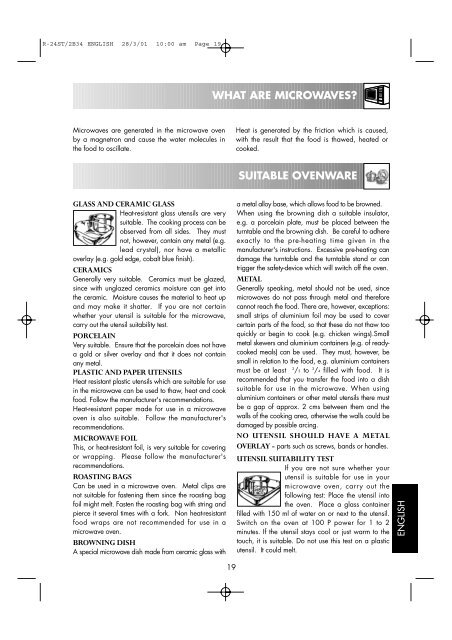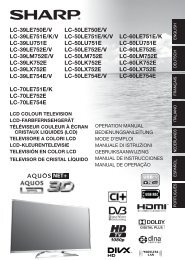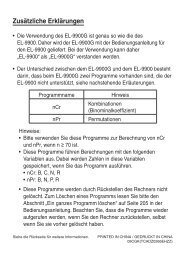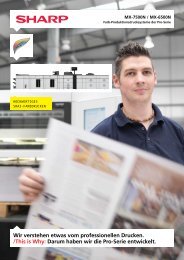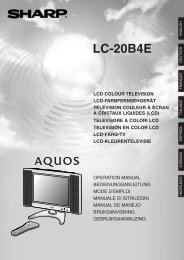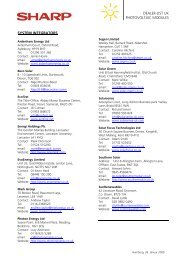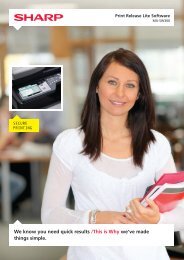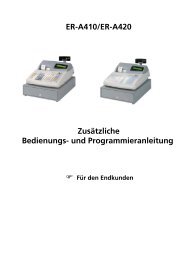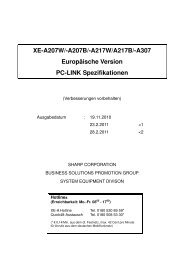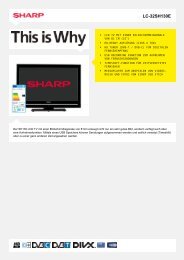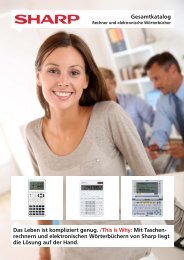r-24st / r-2b34 microwave oven operation manual with cookbook
r-24st / r-2b34 microwave oven operation manual with cookbook
r-24st / r-2b34 microwave oven operation manual with cookbook
You also want an ePaper? Increase the reach of your titles
YUMPU automatically turns print PDFs into web optimized ePapers that Google loves.
R-24ST/2B34 ENGLISH 28/3/01 10:00 am Page 19<br />
Microwaves are generated in the <strong>microwave</strong> <strong>oven</strong><br />
by a magnetron and cause the water molecules in<br />
the food to oscillate.<br />
GLASS AND CERAMIC GLASS<br />
Heat-resistant glass utensils are very<br />
suitable. The cooking process can be<br />
observed from all sides. They must<br />
not, however, contain any metal (e.g.<br />
lead crystal), nor have a metallic<br />
overlay (e.g. gold edge, cobalt blue finish).<br />
CERAMICS<br />
Generally very suitable. Ceramics must be glazed,<br />
since <strong>with</strong> unglazed ceramics moisture can get into<br />
the ceramic. Moisture causes the material to heat up<br />
and may make it shatter. If you are not certain<br />
whether your utensil is suitable for the <strong>microwave</strong>,<br />
carry out the utensil suitability test.<br />
PORCELAIN<br />
Very suitable. Ensure that the porcelain does not have<br />
a gold or silver overlay and that it does not contain<br />
any metal.<br />
PLASTIC AND PAPER UTENSILS<br />
Heat resistant plastic utensils which are suitable for use<br />
in the <strong>microwave</strong> can be used to thaw, heat and cook<br />
food. Follow the manufacturer's recommendations.<br />
Heat-resistant paper made for use in a <strong>microwave</strong><br />
<strong>oven</strong> is also suitable. Follow the manufacturer's<br />
recommendations.<br />
MICROWAVE FOIL<br />
This, or heat-resistant foil, is very suitable for covering<br />
or wrapping. Please follow the manufacturer's<br />
recommendations.<br />
ROASTING BAGS<br />
Can be used in a <strong>microwave</strong> <strong>oven</strong>. Metal clips are<br />
not suitable for fastening them since the roasting bag<br />
foil might melt. Fasten the roasting bag <strong>with</strong> string and<br />
pierce it several times <strong>with</strong> a fork. Non heat-resistant<br />
food wraps are not recommended for use in a<br />
<strong>microwave</strong> <strong>oven</strong>.<br />
BROWNING DISH<br />
A special <strong>microwave</strong> dish made from ceramic glass <strong>with</strong><br />
WHAT ARE MICROWAVES?<br />
19<br />
Heat is generated by the friction which is caused,<br />
<strong>with</strong> the result that the food is thawed, heated or<br />
cooked.<br />
SUITABLE OVENWARE<br />
a metal alloy base, which allows food to be browned.<br />
When using the browning dish a suitable insulator,<br />
e.g. a porcelain plate, must be placed between the<br />
turntable and the browning dish. Be careful to adhere<br />
exactly to the pre-heating time given in the<br />
manufacturer's instructions. Excessive pre-heating can<br />
damage the turntable and the turntable stand or can<br />
trigger the safety-device which will switch off the <strong>oven</strong>.<br />
METAL<br />
Generally speaking, metal should not be used, since<br />
<strong>microwave</strong>s do not pass through metal and therefore<br />
cannot reach the food. There are, however, exceptions:<br />
small strips of aluminium foil may be used to cover<br />
certain parts of the food, so that these do not thaw too<br />
quickly or begin to cook (e.g. chicken wings).Small<br />
metal skewers and aluminium containers (e.g. of readycooked<br />
meals) can be used. They must, however, be<br />
small in relation to the food, e.g. aluminium containers<br />
must be at least 2 /3 to 3 /4 filled <strong>with</strong> food. It is<br />
recommended that you transfer the food into a dish<br />
suitable for use in the <strong>microwave</strong>. When using<br />
aluminium containers or other metal utensils there must<br />
be a gap of approx. 2 cms between them and the<br />
walls of the cooking area, otherwise the walls could be<br />
damaged by possible arcing.<br />
NO UTENSIL SHOULD HAVE A METAL<br />
OVERLAY - parts such as screws, bands or handles.<br />
UTENSIL SUITABILITY TEST<br />
If you are not sure whether your<br />
utensil is suitable for use in your<br />
<strong>microwave</strong> <strong>oven</strong>, carry out the<br />
following test: Place the utensil into<br />
the <strong>oven</strong>. Place a glass container<br />
filled <strong>with</strong> 150 ml of water on or next to the utensil.<br />
Switch on the <strong>oven</strong> at 100 P power for 1 to 2<br />
minutes. If the utensil stays cool or just warm to the<br />
touch, it is suitable. Do not use this test on a plastic<br />
utensil. It could melt.<br />
ENGLISH


